Featured
Hunger fight goes on the road
September 30, 2010
Hunger, like homelessness, remains a national shame and an incredible stain on the richest society on earth. It seems inconceivable, but it is an indisputable fact that a rising number of our fellow citizens are going to bed hungry every night.
Food stamps are an important weapon in this battle, but we estimate that only about 50% of the people in Los Angeles County who are eligible are actually receiving this crucial assistance.
That’s why I was so encouraged to see the county rev up a new tool in the fight against hunger the other day. The Department of Public Social Services’ new mobile “Health and Nutrition Mobile Unit” is going to be hitting the streets, moving into our communities to find people who are eligible for food stamps and signing them up.
This 34-foot custom-made traveling office, fully equipped with computers, will be a rolling alternative to the status quo, in which food stamp applicants usually go to a county DPSS office, which unfortunately, for some, still carries a stigma. With this van, we can bring the mountain to Mohammed, so to speak.
But any successful innovation is about more than just equipment. This effort also will be tapping into the incredibly valuable human resources of our non-profit organizations—like the St. Joseph Center in Venice, where the van was unveiled, and the L.A. Jewish Federation, which since last fall has been running a “Fed Up With Hunger” campaign.
The nonprofits’ staff workers and volunteers will be on the front lines of this new outreach effort, identifying candidates for food stamps and assisting them with the time-consuming paperwork that is required on the front end. That way, when county workers show up in the van, they will be able to handle their end of the process more quickly and efficiently.
And reaching as many people as possible is the name of the game in these tough times.
Over the past year, we have seen demand at food pantries go up from 50% to 125%.
Yet many who should be receiving food stamps haven’t applied for them. Helping these individuals and families put nutritious food on the table will set up a win-win situation for all involved.
For one thing, these new clients (who, by the way, will be using electronic cards for their purchases, not stamps or vouchers) will be bringing business to our local supermarkets and grocery stores.
For another, they’ll be able to access an array of other services at the same time they sign up for food stamps—including mental health, housing and health care assistance.
We’ll essentially become a one-stop operation to help make life better for many of the folks who need a hand these days. And we’ll be doing it out in the neighborhoods where the need is greatest. So, as the old saying goes, let’s get this show on the road.
To hear Zev discuss the need to increase access to food stamps, watch the DPSS video below.

Posted 9/30/10
Soaring over the Santa Monicas
September 21, 2010
Those of you who have followed my blog and website know that I have a passionate love for and dedication to the Santa Monica Mountains. A new high definition aerial video of this beautiful part of our county is currently being created, and I’d like to share an early look at it with you.
Eventually, this spectacular footage will be on display for visitors who come to the Santa Monica Mountains National Recreation Center from around the world. (See our story on the project here.) It will provide an incredible visual introduction to this unique natural resource, which combines spectacular mountains, seashore, canyons and wildlife. As this video clip shows, there are very few places in our nation that possess the Santa Monicas’ immense beauty and resource value in such close proximity to a metropolis the size of Los Angeles.

And the grandeur of the Santa Monica Mountains parks system is still growing. We’re continuing to add to it with our partners in the national and state parks service. While these are tough times for all of us, when once-in-a-lifetime acquisition opportunities such as the Ahmanson Ranch or the King Gillette properties pop up, we have to be ready to strike. Once we lose these lands to development, we lose them forever.
When you view this video, I think you will agree with me that we have something special and worth preserving in these rugged and majestic mountains, and we should do whatever we can to preserve them for future generations.
Enjoy the flight!
Posted 9/21/10
Golden voice, golden man
August 26, 2010
For our Boys of Summer—the fading L.A. Dodgers—it’s almost time to sadly invoke that old bromide, “Wait ‘till next year.” But for our Voice of Summer—the incomparable Vin Scully—that saying is cause for celebration. Scully has announced he’s returning for another year, his 62nd with the Dodgers, dating back to the Brooklyn days.
For me, and millions of you, his voice has been an uplifting summer soundtrack for decades—musical in its rhythm and lyrics.
In junior high, I remember carving out the pages of one of my dad’s books (a prized book, it turns out) so I could hide a transistor radio and listen in class to Scully call the ’63 World Series. Of course, I got caught—with no regrets.
Years later, as a new UCLA grad, I wrote to Dodgers owner Walter O’Malley offering my services in the booth alongside Vin. Mr. O’Malley wrote back saying thanks, but that the broadcast team was in good shape.
Then, in my early 50s, I had the honor of interviewing Scully on radio station KPCC for 30 minutes. I’d ask a question and off he’d go—eloquent, funny, profound.
Yes, here in Los Angeles we’re facing serious social and economic problems. But it’s good to know that, like in so many years past, one transcendent man will be there to provide comforting continuity amid the changes and challenges.
Posted 8/26/10
Why Project 50 saves lives
August 2, 2010
If you want to solve homelessness in Los Angeles, you have to start on Skid Row.
I heard that observation voiced by a participant at a conference I convened in 2007. The words rang true to me then, as they do now. It is a simple declaration of a difficult fact: that Job One in fixing the national disgrace at the heart of downtown means trying some innovative tactics to begin alleviating some of the miseries endured by individuals on the street there.
The Los Angeles Times is now in the midst of a four-part series chronicling Project 50, the initiative that grew out of that conference. As the first story points out—and as the newspaper suggests in promoting the upcoming installments—it has been a difficult journey, with many hard-won successes and some disappointments along the way.
Project 50 is one of the most rewarding public policy initiatives I have ever sponsored. Its foundations were established at that 2007 conference, sponsored by the Rockefeller Foundation. We brought people to Los Angeles from across the country—people who had successfully turned around homelessness in their own cities and counties. Before meeting with our policy makers and civil servants, these out-of-town participants toured Skid Row, and every one came away recommending that we start there.
Roseanne Haggerty, who runs Common Ground, a New York non-profit that deals with homelessness, suggested we launch a pilot that would identify the most vulnerable homeless people on Skid Row—those most likely to die on our streets. Then, we’d find them a place to live and give them the services they needed. In the language of homeless advocates, this is called permanent supportive housing.
Since we would be going after the most troubled people—the hardest cases who for years had resisted every program to come along—we needed to be innovative to reach them. So we broke with conventional practice and did not make it a precondition that participants accept services in order to get a roof over their heads.
But once we got them housed, our county and affiliated non-profit agencies had one, unified goal: to surround them with the health care, mental health care and substance abuse services they required.
It was a relentless mission. Once these clients moved in, our people were on them like a wet blanket, pushing to get them the help they needed.
And here’s the striking part: every single participant ended up agreeing to accept at least one kind of treatment.
What has evolved in the last 2 ½ years has been nothing short of remarkable. Project 50 has actually housed 68 homeless persons, most of whom had health, mental health and substance abuse issues. Many had been homeless on the streets of Los Angeles for more than 10 years; one had been homeless for 37 years. These were the most challenging of the challenged homeless persons in our county. And because of Project 50, we were finally able to break through—not to all, but to a very substantial majority.
Since 2008, nearly 84% of those we housed remain housed, a statistic which has left in tatters the myth that we can’t get chronically homeless persons into housing. And 100% of the clients have received one or more of the health care, mental health or substance abuse treatments they desperately needed.
A collateral benefit is that this pilot has been a money saver as well—a point recognized by the Economic Roundtable and others. The cost of running this program is more than made up by the savings realized by the relative stability that has been restored to our clients. Before Project 50, most of its participants landed in jail or in hospital emergency rooms multiple times each year. Since being in the program, most have avoided incarceration or hospitalization at a considerable financial savings to taxpayers.
And when progress is measured in human lives saved—lives that almost certainly would have been lost on the streets without Project 50—that represents a success well worth celebrating and replicating.
Project 50 has rapidly expanded beyond Skid Row to other parts of the county. Nearly 400 permanent supportive housing units are in the pipeline in West L.A., Van Nuys, Venice, Santa Monica, Hollywood, West Hollywood and Long Beach. Other communities have expressed serious interest as well.
Los Angeles has often been called the homeless capital of the nation, and one could hardly argue with that moniker. It can be very daunting to try to address the housing and service needs of well over 10,000 chronically homeless people in our county. That’s why dealing with them 50 or 500 individuals at a time made so much sense to me. Project 50 established the template. The same methodology that was applied to housing 50 chronically homeless can be applied to 500 or 5,000.
Thanks to this project, and its courageous and dedicated county employees and their non-profit partners, we are on our way.
Posted 8/02/10
L.A. Times columnist Steve Lopez has weighed in on Project 50, praising its hard-won successes for the chronically homeless on Skid Row as “no small triumph.” Read his column here. And our article on the Project 50 debate that cropped up at last week’s Board of Supervisors meeting is here.
John Wooden remembered
June 8, 2010
I consider it one of the greatest privileges of my life that, over the years, I was able to share quality time with UCLA Coach John Wooden. Coach, as we all called him, died last Friday night, only months shy of his 100th birthday. He was as influential a teacher and life coach as I’ve ever met.
I first encountered Wooden when I was a UCLA student. In 1970, as the campus was roiled in protest, I passed by the Royce Hall steps and saw a peaceful and intently engaged crowd gathered around him. I stopped and listened as they talked basketball, politics and academics. What was striking about the scene was the serenity of the crowd. Without knowing it, Wooden had brought a sense of calm to the turbulent campus and to all of us who hung on his words. When he headed toward Pauley Pavilion, I shook his hand and went about my business at the Research Library.
I didn’t meet Coach again for several years, not until I’d been elected to the City Council. I had invited him to City Hall to present him with a resolution after he retired from coaching. The signed picture of that ceremony still hangs proudly in my office.
Back then, I still viewed him mostly as a sports hero of epic proportions. But that would change when, many years later, I got the opportunity to know Coach Wooden, the person. Thanks to mutual friends and UCLA classmates, I found myself one night having dinner with him. We talked about his life and his philosophy and a bit about sports. One dinner led to another, and over the years, I must have spent a couple dozen afternoons and evenings in his presence.
The more I got to know him, the more I came to understand that the world view he offered was far more profound than any national championship—even 10 of them. I bought all of his books and read them religiously. I discussed his writings with him and listened intently to his soft spoken but powerful story-telling of his life experiences. Always, it was about the lasting things in life—values, philosophy, Shakespeare, the Bible and the countless poets whose prose he could recite from memory, even in his 99th year.
A bunch of us who were associated with UCLA would take him out to dinner around his birthday every year at the Valley Inn in Sherman Oaks, one of his favorite haunts. For the last many years, it was a standing appointment on my calendar. Nothing, absolutely nothing, would get in the way of that dinner. The attendees included people with whom Wooden had a decades-long relationship (how I got into that group is beyond me, but I never asked questions). His friends included former UCLA Chancellor Charles Young, former football coach Terry Donahue, former Athletic Director Pete Dalis and several others.
This was a group of pretty accomplished individuals with healthy egos and resumes. Stories abounded at these dinners as each member of the group regaled Wooden with reminiscences of their times together. Generally, Coach just listened. But once in a while he’d choose to speak. When that happened, this group of powerful and influential friends would fall silent—one and all, a dozen or more of us. It was not only a sign of respect, but also a genuine desire to harvest the wisdom from his words.
During one of those dinners, Wooden quoted from a poem that one of his former players, retired Vice-Chancellor Pete Blackman, wrote around 1960. It recounted a road trip the Bruins had taken to Houston. When the team arrived at the motel, the check-in clerk advised Wooden that there were rooms reserved for the white members of the team but that the black members would be sleeping in a place reserved for them in the basement.
The players and Coach Wooden huddled and decided they’d all leave the motel and find someplace else that night, even though there was no guarantee they’d be able to find any place that would take all of them in—black and white. Blackman’s poem memorialized that night. I don’t remember the verse but, 45-years-later, Wooden did, reciting it to us without missing a beat or skipping a word. It gave us chills, one of those moments none of us will ever forget.
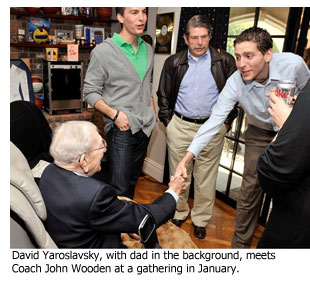 Last January, the last time I saw Coach, my friend Angelo Mazzone was hosting a brunch at his home for Wooden. The guest list was very limited. It included many of Wooden’s family members, along with Joe Torre, Mike Scioscia, Bill Sharman, Vin Scully and a few others. What ensued were several hours that I only wish we had videotaped. There was Wooden, physically frail but mentally sharp, sitting across from Dodgers’ manager Torre and Angels’ manager Scioscia, who were exchanging stories about their experiences in baseball and as life coaches. (Wooden loved baseball and had a great baseball mind. In fact, around 1970, the Pittsburgh Pirates asked him to be their manager, an offer he respectfully declined).
Last January, the last time I saw Coach, my friend Angelo Mazzone was hosting a brunch at his home for Wooden. The guest list was very limited. It included many of Wooden’s family members, along with Joe Torre, Mike Scioscia, Bill Sharman, Vin Scully and a few others. What ensued were several hours that I only wish we had videotaped. There was Wooden, physically frail but mentally sharp, sitting across from Dodgers’ manager Torre and Angels’ manager Scioscia, who were exchanging stories about their experiences in baseball and as life coaches. (Wooden loved baseball and had a great baseball mind. In fact, around 1970, the Pittsburgh Pirates asked him to be their manager, an offer he respectfully declined).
Again, like those of us at the Valley Inn, Torre and Scioscia were in awe of Wooden. They asked if he had ever seen Babe Ruth or Lou Gherig play, or whether he had ever met Dizzy Dean or Joe DiMaggio. These highly accomplished men behaved like kids with a chance to chat with their hero and get a glimpse of history. But they, too, knew he was bigger than sports, coaxing him into imparting words that they might carry into their own futures.
I sat at the table just taking it all in, feeling blessed for the extraordinary opportunity. I had brought my grown son with me knowing that this might be the only chance he’d have to spend any kind of meaningful time with Wooden. David didn’t squander the opportunity. He asked Wooden the name of his favorite book. “The Bible,” Wooden responded. My son then asked the name of his next favorite book. “Many of the books written about Abraham Lincoln,” Wooden said. “I’ve always been interested in Lincoln.”
Indeed, Wooden often cited one of Lincoln’s quotes: “Most anyone can stand adversity, but to test a person’s character, give them power.” That gave us all food for thought.
What has been so interesting about the passing of John Wooden is the amount of attention given to his philosophy of life and his role as a teacher and life coach. We’ve heard this from his players, his associates, his family and his friends. It’s worth noting that while Wooden coached at UCLA for 28 years, he has been retired for 35 years, time he certainly didn’t waste. He lectured and wrote. He spoke to school assemblies and charitable organizations. He rarely turned down a speaking invitation and never refused an autograph request.
Coach Wooden never wore his philosophy on his sleeve. He simply lived it. That is what I’ll remember most about him and that is what will endure of his life. In the last few days I’ve reviewed many of Wooden’s philosophies, and I’ll close by sharing some that most resonate with me:
- “Ability gets you to the top; character keeps you there.”
- “Character is more important than reputation, because reputation is merely what other people think of you; character is what you really are, and only you know what that is.”
- “Failure is not fatal, but failure to change might be.”
- “You are your word. Don’t give your word unless you intend to keep it. A leader whose promise means everything is trusted.”
- “The star of every successful team is the team. Individuals don’t win games, teams do.”
- “The purpose of criticism is to correct, improve and change. It is not to humiliate, demean, or punish.”
- “Don’t confuse activity with achievement.”
- “Favor firm suggestions over strict rules.”
- “Practice doesn’t make perfect; perfect practice does.”
- Great leaders give credit to others, but accept the blame themselves.”
Rest in peace Coach John Wooden.
Posted 6/8/2010
Maestro on a mission
May 27, 2010
A few years ago, a former LAPD commander I knew from my days on the City Council wrote me an interesting letter. It wasn’t about the latest crime-fighting or community policing strategies—at least not in the usual sense of those terms. Instead, he wrote to urge me to keep pushing for musical education and expanded access to classical music in our county. His reason? “I never arrested a youngster who played a musical instrument.”
I viscerally understood what he meant. As a youngster, I was what we call today a “latchkey child.” My mother died when I was 10, and my dad worked afternoons and evenings. Fortunately, in those days we still had musical education in our public schools. When I entered Bancroft Jr. High School in Hollywood, I joined the “Beginning Woodwinds” class and was assigned the oboe, one of the most difficult instruments in the orchestra. For three years I religiously rehearsed at school and practiced at home.
That oboe was a loaner, but I got to keep something important: an unforgettable educational experience that not only broadened my cultural horizons but also, as I now realize, kept me out of trouble.
All of this came back to me on Saturday afternoon, when I went to the Walt Disney Concert Hall to watch Gustavo Dudamel conduct Youth Orchestra Los Angeles (YOLA). This is a music education program undertaken by the Los Angeles Philharmonic and inspired by Venezuela’s legendary El Sistema, which produced Dudamel.
El Sistema–created in 1975 by the visionary Dr. Jose Antonio Abreu, who still oversees it–has placed musical instruments in the hands of hundreds of thousands of Venezuelan youth and created orchestras in all of the country’s major cities, and many of the smaller ones as well. It’s more than a musical exercise; it’s an incredibly powerful social program with an international message that’s going viral. The best of the El Sistema musicians make up the internationally acclaimed Simon Bolivar Orchestra, which tours the world and last year thrilled Los Angeles audiences at Disney Hall.
Now, with Dudamel as the Philharmonic’s Music Director, the El Sistema-style program started here in 2007 is on the verge of great things. YOLA now has 300 participants who observe a rigorous practice and rehearsal schedule after school. While the program here was intentionally started slowly, its growth is imminent and inevitable.
I first heard the orchestra last summer, and while they struggled with the music, you had to love the kids and their enthusiasm. They’ve come a long way since then. These kids have already played the Hollywood Bowl, and can now they can say that they’ve made it to Disney Hall, too.
The orchestra members–a sea of red, yellow, green, purple and blue T-shirts—took their places Saturday on the internationally-famed stage before an audience of about 1,000 family, friends and orchestra supporters. Their rehearsal with Dudamel was the closing event in a three-day symposium called “Composing Change: YOLA and the El Sistema Movement.”
Even playing hurt, having pulled a neck muscle earlier in the week, Dudamel exuded an infectious warmth and humor from the moment he stepped onstage. He started out by not just shaking the hand of the young concertmaster, but also patting his head.
Their first piece of business—going over a difficult minor key march from Mahler’s First Symphony—gave way to an enthusiastic rendition of the main theme from “Star Wars” and, finally, to a fun and rousing reading of “Chamambo.”
It was an unforgettable hour for these kids, who represent every ethnic and racial group in L.A. Every hour they spend practicing, they learn the value of hard work and team work. What a life lesson: that by working together and subordinating their own urges, they can produce great music. (Some of our political leaders could stand to learn that lesson, too.) And, from the social policy point of view, every hour the kids spend with the orchestra or practicing at home is an hour they are not susceptible to the vicissitudes of growing up in today’s urban America.
YOLA is just getting started. It’s no El Sistema—yet–but the journey has begun. Dudamel closed the rehearsal by praising the kids for “giving the message and music of our people and our continent. How? Because they have an instrument in their hands.”
And that’s worth a round of applause from all of us in Los Angeles.
For more on YOLA, check out the Philharmonic’s website, and read our earlier story about the orchestra here.
Here’s a video look at Youth Orchestra Los Angeles:
http://www.hollywoodbowl.com/media/video/flv/yola_103.flv
Posted 5-10-10
No butts about it
October 1, 2009
 It’s official: If you’ve got ‘em, don’t smoke ‘em. That’s now the law in Los Angeles County’s public parks and golf courses.
It’s official: If you’ve got ‘em, don’t smoke ‘em. That’s now the law in Los Angeles County’s public parks and golf courses.
With evidence mounting about the dangers of secondhand smoke, county officials have banned smoking at more than 125 county parks and facilities, including the Hollywood Bowl and the Ford Amphitheatre, and sharply restricted it in the nation’s largest municipal golf course system.
The county joins numerous other California cities and counties in imposing smoking restrictions in parks that are tougher than state law.
“Ninety-five percent of our facilities are now smoke-free from curb to curb,” says Mika Yamamoto, Unincorporated Areas Liaison in the executive officer of the Department of Parks and Recreation.
Now parks officials are working on making signs and informing staffers, volunteers and sports league representatives about the new policy. They also are setting up meetings with concessionaires about establishing designated smoking areas.
The move to ban smoking in Los Angeles County’s parks was initiated last year in a motion by Supervisor Yaroslavsky and approved by the board. The motion asked the directors of the public health and parks and recreation departments to study the health and fiscal implications of a proposed smoking ban and to report back.
Their report recommended an outright ban on smoking at all local community and regional parks, arboretum and botanic gardens, equestrian centers, natural areas and sanctuaries.
But the recommendations stopped short of calling for an end to smoking at the county’s 19 golf courses. Operators of municipal golf courses throughout the region contended that such a ban could lead to fewer visitors and thus be economically harmful. The report recommended instead that smoking be prohibited in areas where people congregate, including driving ranges and practice areas such as putting and pitching greens. The ordinance went into effect Oct. 22.
The parks department is expecting a positive response to the ban—even from smokers.
“We believe that most often people will say, ‘Oh I didn’t know’ or ‘Thanks for letting me know.’ We’re anticipating getting a lot of cooperation,” Yamamoto says. “Most people want to do the right thing.”
The latest effort to protect the public from the demonstrably harmful effects of secondhand smoke is the logical next-step to a county policy adopted in 2004 that banned smoking at beaches.
“The creation and adoption of a smoke-free policy in county parks,” Yaroslavsky said in his motion, “is another important step towards improving the health of our children and families.”




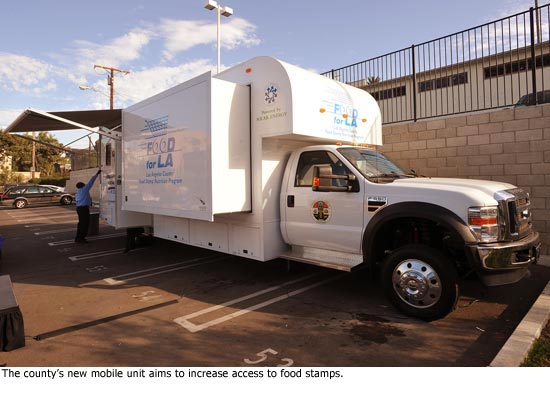

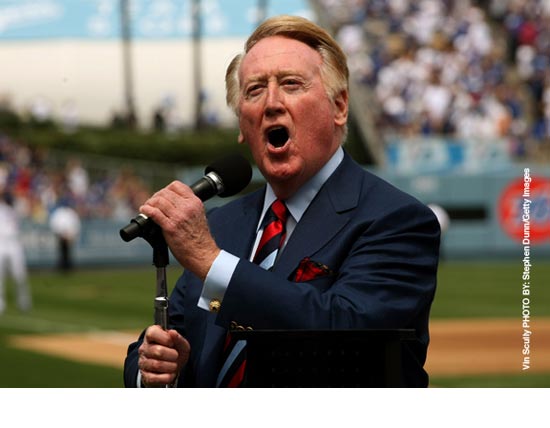

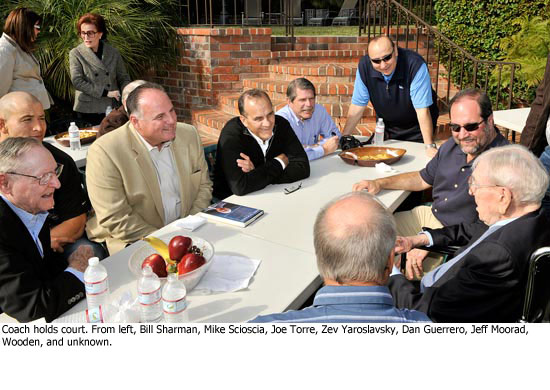

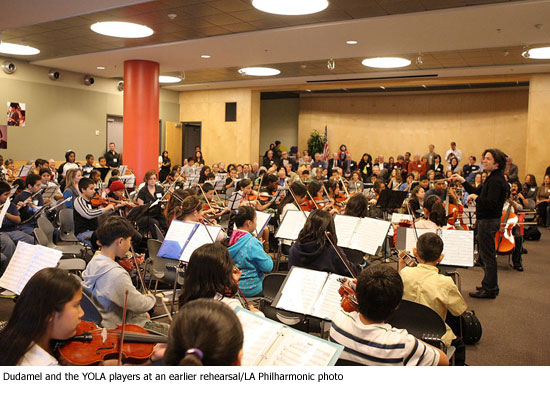





 Check for the latest closure information
Check for the latest closure information








